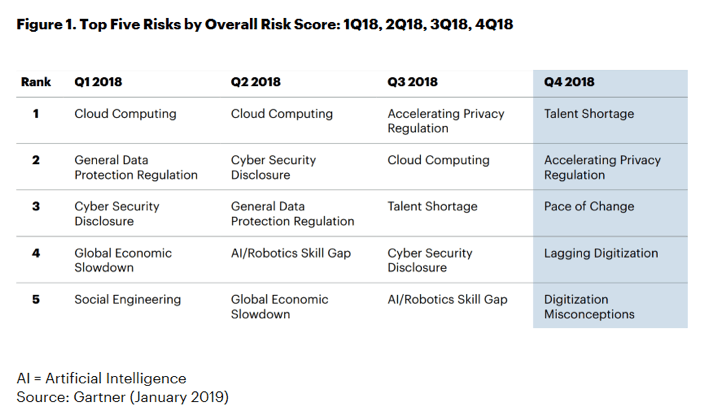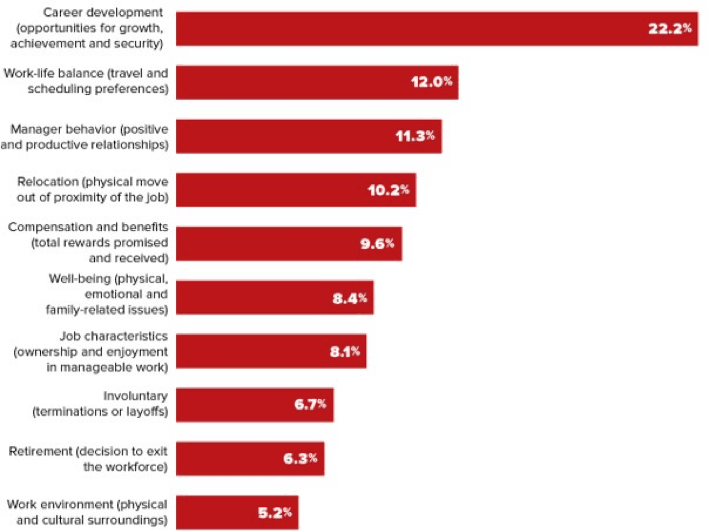Even before the COVID-19 pandemic crisis, talent management and skills shortage had been rising to the top of the agenda for CIOs, their HR and Learning & Development colleagues, and others in senior management. For example, according to Gartner, 2018 ended with Talent Shortage as the top IT risk. Digital, IT, cybersecurity, and other technology-focused specialists are not only in high demand but also toward the top of the tables in terms of IT staff turnover (thanks to the high demand). Hence, IT staffing and skills should be an area of concern and investment.

The analysis of turnover causes highlights that the biggest reason that people think about leaving is that they’re concerned about the lack of opportunity, and see a stronger career path elsewhere. Plus, some are dissatisfied with management, others want more challenging work, and some are attracted by better pay and benefits (as shown below).

Even before the COVID-19 crisis, IT staff churn was expected to continue to get worse. One 2019 report stated that one in four IT pros planned to seek new employment. So, organizations need to work harder to hold on to the good ones!
Even before the COVID-19 crisis, IT staff churn was expected to continue to get worse, says @MatthewKBurrows #COVID19 #ITSM Click To TweetThe IT staffing and skills shortages were getting worse before COVID-19
At least 133 million new roles generated as a result of the new division of labor between humans, machines, and algorithms may emerge globally by 2022, according to the World Economic Forum. And an overview of the technology domain globally (with data from various sources – Deloitte, Forbes, Gartner, Accenture, McKinsey, CIO Magazine, Gallup, and Human Resources Today) offers up the following statistics:
- 71% of CIOs report that skill gaps will affect their business
- 75% of organizations will experience visible business disruption caused by skill gaps
- 70% of employees have not mastered the skills they need for their jobs today
- Only 16% of executives believe that their teams have the capabilities to deliver their digital strategy
- 37% of employees said their current jobs did not fully use their skills
- 51% of employees are actively looking for a new job
- 22% of leavers say the top reason is lack of career development opportunities
- The #1 risk facing organizations is talent shortage
- Only 2 in 10 organizations are taking tangible action to address skills gaps.
The impact of the COVID-19 crisis on IT staffing and skills
The COVID-19 pandemic is forcing a significant change to our patterns, both at work and from a personal perspective. Some people are finding themselves out of work, furloughed temporarily, or with an uncertain future due to the economic impact. We don’t yet know how long this will take to play out or what the recovery will look like. We can, however, take positive steps to protect our wellbeing, and that of our employees, and to put us in a better position both now and for the future. This is summarized below in my views on IT staffing and skills.
The challenge:
Up to 25 million job losses due to COVID-19 according to the UN International Labor Organization (18 March 2020)
The opportunity:
At least 133 million new digital roles generated globally by 2022 according to the World Economic Forum (12 March 2019)
The required action:
Use this time to reskill the existing workforce and those currently out of work.
We don't know how long the #COVID19 pandemic will last... we can, however, take positive steps to protect our #wellbeing, and that of our employees, and to put us in a better position both now and for the future – @MatthewKBurrows Click To TweetHow to survive the COVID-19 crisis as an IT employer
I think most organizations are aware of market-based IT staffing and skills issues. Now, survival during the pandemic is further highlighting the importance of skills management and driving the following actions:
- Building a complete skills inventory. Know all of the skills of your current workforce – not just the skills they’re using in their current role, as you may need to ask people to perform different tasks or stand in for resources who are unavailable.
- Identifying and prioritizing the skills your organization needs. For example, consider business continuity needs, identifying roles that need filling and skills gaps that need addressing.
- Finding people with the best fit. Sometimes the fit might not be perfect, you might be asking people to resurrect skills from earlier in their career or to do their best with only a partial match to a role.
- Planning and executing development actions. Give the workforce the support they need to develop the required skills for current and future roles. In the worst-case scenario, some of these workers may need support to prepare for different jobs in the future.
What does the future hold?
It’s true that some people will lose their jobs, and find themselves looking for work.
Organizations may need to change their operating model and the organizational skills profile, and respond to a different economic reality.
In light of COVID-19, orgs may need to change their operating model and the organizational skills profile, and respond to a different economic reality, says @MatthewKBurrows. #ITSM #COVID19 Click To TweetWe don’t know if the same number of opportunities will exist in our current roles, so change is probably inevitable. Organizations are using SFIA (the Skills Framework for the Information Age) to identify, attract, and develop the skills and talent they need. SFIA provides a common international language for describing skills/competencies.
Prepare digital skills for a future in the data economy
It’s also true, however, that we currently have shortages in some skills, and an ever-evolving requirement for additional digital, ICT, cybersecurity and other technology-related specialists. Even before this pandemic, there was a need to identify what will be required and develop or recruit people for these new roles.
Use your time wisely during the crisis
During the crisis, there’s increased opportunity for some individuals to develop new skills and complete online training to better prepare for a future that might involve a change in responsibilities or job.
What we’ve learned from other organizations that are getting this right are that the vital ingredients for closing the current and future IT skills gaps are:
- A consistent competency (skills) framework – such as SFIA
- Knowing what skills your organization has against the framework
- Knowing what skills your organization needs now and into the future
- Skill gap analysis
- Career development action plans.
If you’d like to know more about what other organizations are doing to tackle IT skills gaps, then please leave me a comment or connect with me on LinkedIn.
Matthew Burrows
Matthew Burrows currently serves on the SFIA Council, is Chair of the itSMF International Ethics Review Board, and contributes to the Service Management industry and the development of best practice – including as Design Authority for SFIA.
He is Director and Principal Consultant of BSMimpact, an ISO/IEC 20000 qualified consultant and auditor, and SFIA Accredited Consultant, specialising in implementing pragmatic business service management solutions rather than just theoretical consulting. He has considerable practical and operational experience of Service Management.
Matthew’s authoring credits include SFIA (Skills Framework for the Information Age), Service Management, Portfolio and Programme Management methodologies, white papers, books, articles and publications.

